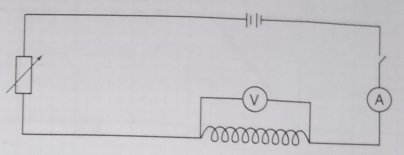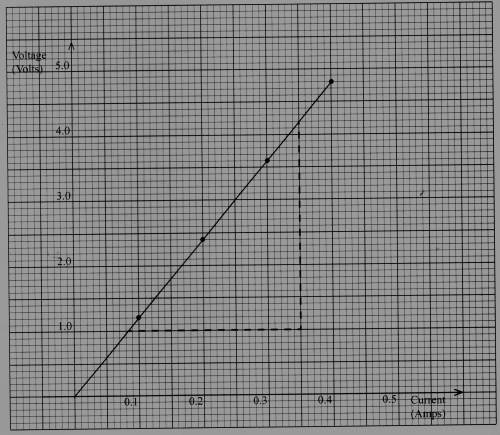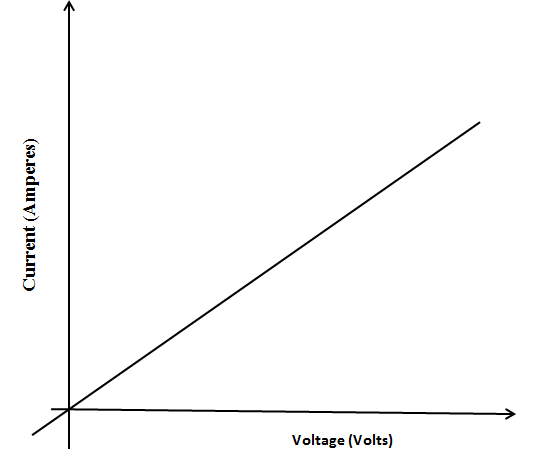Georg Simon Ohm
In 1825, Georg Ohm tested wires of varying length, diameter, and material to complete a circuit. He found that his data for current, voltage and resistance could be modeled through a special equation, which we know today as Ohm’s Law.

The Ohm’s law summaries about the relation that exists between the voltage across a conductor and the current flowing through it. To explain and describe Ohm’s law, we can take a nichrome wire and make a coil of many turns. Then, we set up the circuit as shown below.

The current flowing through the coil is varied in steps using a rheostat. The corresponding voltage across the coil is noted. A table of current against voltage as shown below is then be filled.
| Current(A) | |||||
| Voltage(V) |
Typical results from such an experiment is as shown:
| Current(A) | 0.1 | 0.2 | 0.3 | 0.4 | 0.5 |
| Voltage(V) | 1.2 | 2.4 | 3.6 | 4.8 | 6.0 |
When a graph of voltage against current is plotted, a straight line through the origin is obtained . see the figure below.

From the graph, we can see that voltage increases with increase in current. This shows that voltage is directly proportional to current.
From the graph, we can make several deductions:
current increases as voltage across the coil increases, therefore we conclude that:
The graph of voltage against current is a straight line through the origin. The gradient of the graph is the constant of proportionality in the relation. It is known as the resistance of the component.
The standard international unit of measuring resistance is called the Ohm. It is represented by the symbol Ω.
The above observations are summarized in ohm’s law. Ohm’s law states that: the current flowing through a conductor is directly proportional to the potential difference across it, provided the temperature and other physical constants are held constant.
The physical conditions includes pressure and mechanical strains on the conductor.
If graph of current against the voltage was plotted, it would give a straight line through the origin.

The gradient of the graph of current against voltage gives the reciprocal of resistance. that is;
reciprocal of the resistance is referred to as the conductance. Conductance is measured in Siemens (S). Siemens is the reciprocal of the ohms(Ω). In other words unit of conductance is (Ω-1).
1 Siemens = 1 Ω-1
In ohm’s law, the constant of proportionality is the resistance of the conductor. ohms law can also be written be written as :
From ohm’s law, an ohm is defined as the resistance of a conductor when a current of 1 Ampere flowing through it produces a voltage drop of 1 Volt across it’s ends.
Other units of resistance includes:
- 1 kilo ohm (KΩ) = 1000 Ω
- 1 Mega ohm (MΩ) = 1000 000 Ω
Examples
A current of 2 µA is passing through a conductor of resistance 200000 Ω. Calculate voltage across the conductor.
Solution
From ohm’s law: Voltage V = IR
where I is current in Amperes.
The give current is 2 x 10-6 A = 0.000002 A
hence V = 0.00002 A x 200000 = 4.0 V
Example
A battery provides a potential difference of 5.0 V across a circuit to a component that needs 5 µA of current to operate effectively. The lost voltage due to the internal resistance of the battery is 0.6 V. Determine the value of a resistance needed in the circuit to provide this current. Include the battery’s internal resistance in the calculation.
solution
The emf E = 5.0 V
E = Ir + IR
where r is the internal resistance and R the external resistance. I is the total current flowing in the circuit.
Assuming series connection of all components in the circuit: we will calculate the value of R
5.0 = 6.0 V + IR
I = 5.0 x 10-6 A = 0.000005 A
IR = 4.4 V


Leave a Reply